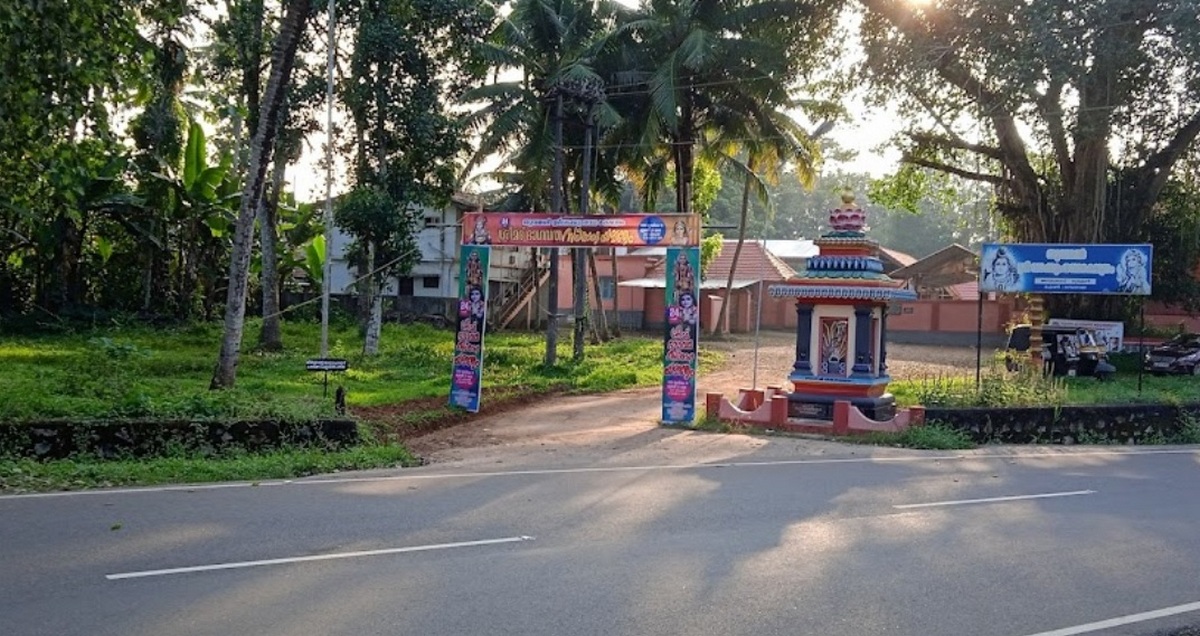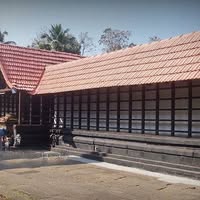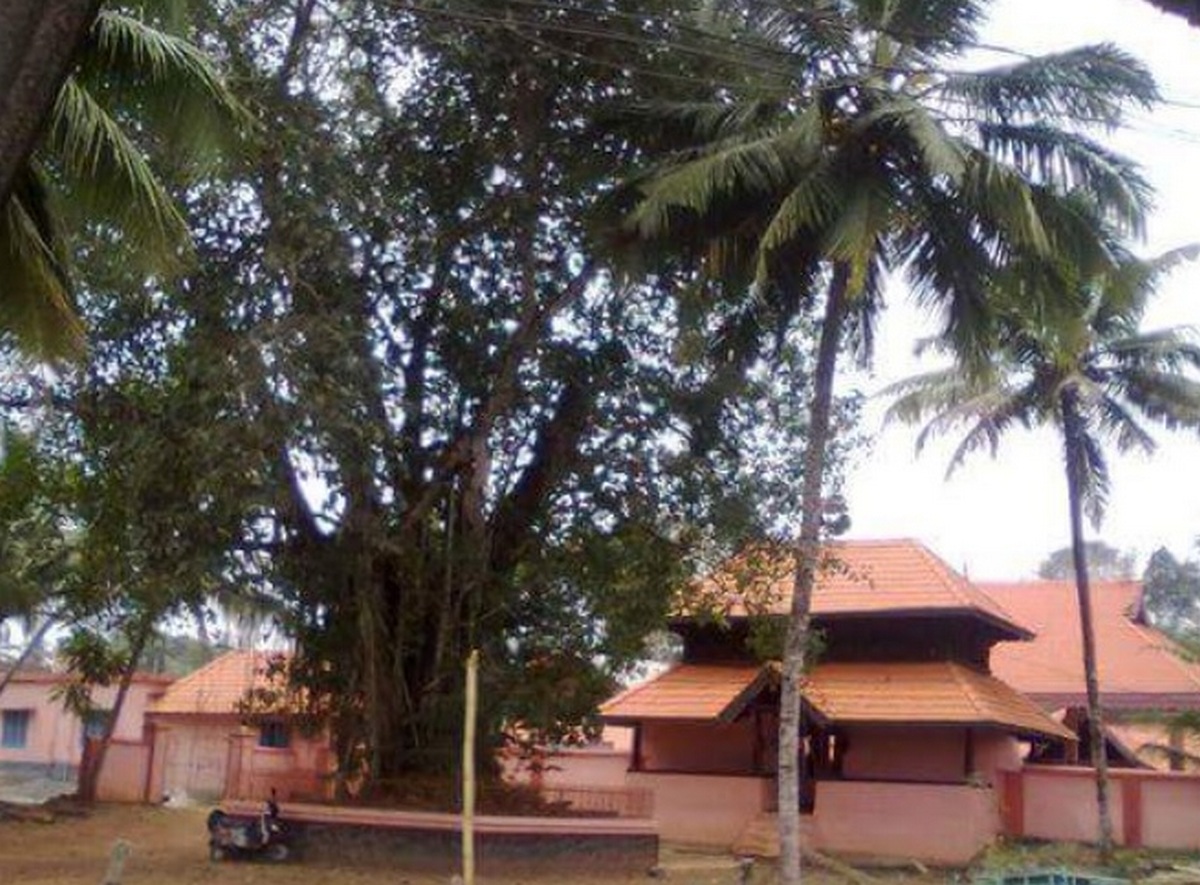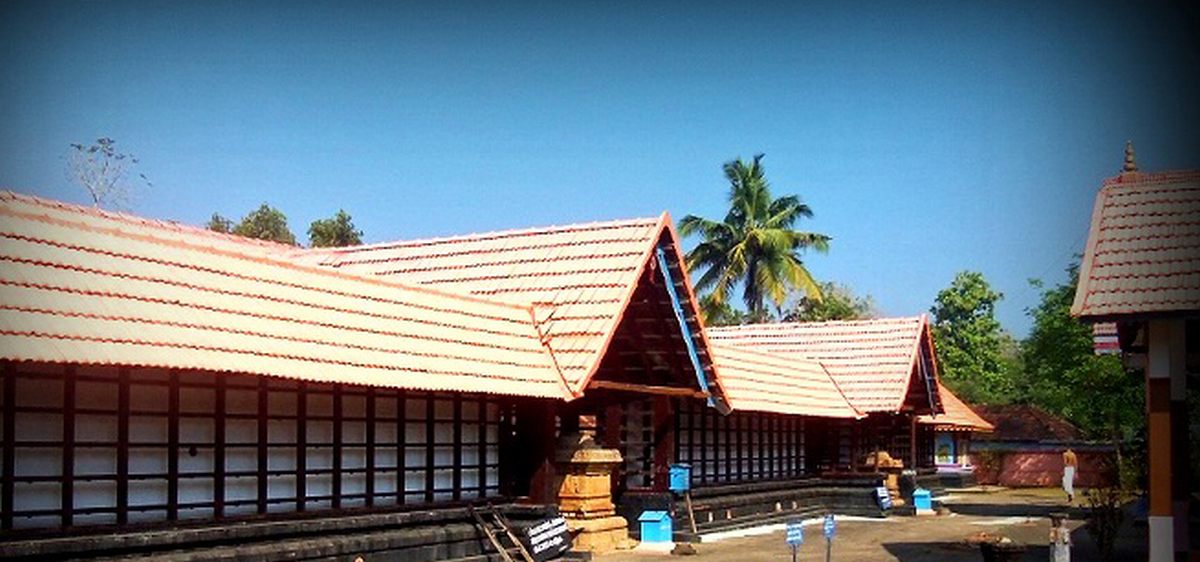Thumpamon Vadakkumnatha Temple, located near Pandalam in Pathanamthitta, Kerala, is a historic site that embodies numerous intriguing legends from ancient times.

Sree Vadakkumnathan Subhramanya Swami Temple features two Sreekovils, also known as sanctum sanctorum, both of which are circular in shape. The primary Sreekovil is dedicated to a deity referred to as Vadakkumnathan. The daily worship rituals for this deity regard him as an embodiment of Lord Subramanya, also known as Murugan or Lord Kartikeya. However, some devotees hold the belief that the deity enshrined in this Sreekovil represents a manifestation of Lord Shiva.
Nonetheless, the notion of Lord Murugan tends to be more widely recognized. The devotees hold the belief that the deity enshrined in the second Sreekovil, referred to as Thekkumnathan, is Balamurugan. It is thought that this deity was venerated by Sakthibhadra, the playwright of Acharya Chudamani, a drama associated with Koodiyattam. The Sreekovil is embellished with exquisite mural paintings that enhance its aesthetic appeal. Significant festivals observed at this temple include Uthrada Maholsavam (the annual celebration known as Thiruvutsavam), Sreemath Bhagavatha Sapthaham, Mahashivarathri, Thaipoosam, Vishu, and Onam, among others.
The Uthrada Maholsavam takes place during the Uthradam star in the Malayalam month of Meenam. The architectural design of Thumpamon Sree Vadkkumnatha temple adheres to the Pancha-Prakara layout, a hallmark of traditional Kerala temples. The Bhakti movement, alongside a resurgence in Hinduism, significantly contributed to the revival of temple construction during this period. The Kularnava Tantra posits that the human body itself serves as a temple, with Sadashiva or Paramathma representing the deity within this sacred space. This philosophical framework has been integrated into the architectural principles of Kerala temples.
In this context, the Sreekovil or Garbhagruham (sanctum sanctorum) symbolizes the head of the deity, while the Antharalam or inner Balivattom represents the face. The Mukhamandapam or Namaskara mandapam is likened to the neck, the Nalambalam to the arms, and the Pradakshinaveethi to the Kukshi Pradesa (stomach). The compound wall is analogous to the legs, and the main Gopuram is interpreted as the foot of the deity.
The Panchaprakaras, which include the Prakaram or compound wall, Bahyahara or Sheevelippura, Madhyahara or Vilakkumadam, Anthahara or Nalambalam, and Antharalam or inner Balivattom, represent the Sthoola Sareera, or the visible aspect of the deity's body. The Deva Prathishta, or idol, situated within the Sreekovil or Garbhagriha, along with the Shadaadharas—comprising Aadharashila, Nidhikumbham, Padmam, Koormam, Yoganaalam, and Napumsaka Shila—constitute the Sookshma Sareera, or the soul of the deity. The Dwajam, or flagstaff, symbolizes the spinal cord of the deity. Consequently, a typical Kerala temple is designed to mirror the human body in its entirety. Recognizing the necessity to establish places of worship that would draw devotees, the Pancha-Prakara scheme has become the benchmark for temple architecture.
The dimensions of these five architectural components are detailed in the Tantra Samucchaya, a treatise on temple architecture compiled around 1300 AD. The five enclosures (Prakaras) surrounding the Sanctum of the Thumpamon Sree Vadkkumnatha temple are as follows:
Pancha-Prakaara Layout
1. Akatthe-Balivattam - (a) This is the innermost enclosure, which houses two Sreekovils dedicated to the principal deities, Vadakkumnathan and Thekkumnathan. (b) Anthar-Mandala: The area surrounding the Sreekovil, occupied by protective deities represented as small stone platforms known as Bali-Kall. (c) Namaskaara-Mandapa: An elevated platform designated for prostrations.
2. Naalambalam / Chuttambalam - This area encircles the sanctum and includes: (a) Valia-Ambalam: Covered spaces adjacent to the Sreekovil intended for rituals and prayers. (b) Thittapalli: A small kitchen serving the temple. (c) Mulayara: A storage area for grains, fruits, utensils, and firewood.
3. Madhya Haara / Vilakku Madom - The Vilakkumadom, a collection of lamps surrounding the temple, which had been lost during the "dark ages," has been recently restored.
4. Puratthe-Balivattam / Sivelippura - The outer enclosure and circumambulatory pathway comprise:
(a) Agra-Mandapa: The pathway leading to the Naalambalam.
(b) Valiya-Balikall: A large, ornately decorated stone platform for sacrificial offerings.
(c) Bali-Peetha: Locations designated for protective deities outside the temple.
(d) Kshetra-Paala: Positions allocated for temple guardians.
(e) Kovil of minor deities: Sub-shrines located within the temple complex. The Sivelippura and Koothamabalam (the area for temple musicians) were lost during the "dark ages."
5. Maryaada / Puram Mathil - The outer boundary wall includes:
(a) Gopuram - A tower that marks the main entrances.
(b) Reconstructed Oottu-Pura: The lunch hall.
(c) Puram-Mathil: The outer wall.
The development of the Thumpamon Sreevadkkumnatha temple is intricately linked to the broader history of significant temples in Kerala, as well as the region's social and cultural evolution.
Scholars categorize the history of temples in Kerala into four distinct phases:
1. The earliest shrines (prior to 300 BC)
2. The era of Jain temples (approximately 300 BC to 500 AD)
3. The period of Buddhist temples (around 200 BC to 800 AD)
4. The resurgence of Hinduism and the emergence of 'new' Brahminical temples (circa 800 AD and beyond).
According to this classification, the Thumpamon Sree Vadkkumnatha temple is categorized within the third and fourth stages. This temple features two Sreekovils (Sanctum Sanctorum), both of which are circular (Vatta) in design. The deity housed in the first Sreekovil is referred to as Vadakkumnatha. There are varying beliefs among worshipers regarding this deity; some identify it as Shiva, while others consider it to be Muruga, and yet another perspective suggests it represents Vishnu.
There is limited historical evidence concerning the deity in the first Sreekovil, Vadakkumnatha. Between 300 BC and 800 AD, Jainism and Buddhism were predominant in Hinduism, both emerging from revival movements within the religion. Buddhism was introduced to Kerala through missions dispatched by Emperor Ashoka, and it thrived in the region for over 700 years. The Paliyam copper plates from the reign of King Varaguna (885-925 AD) indicate that Buddhists in South Kerala continued to receive royal support until around 1000 AD. Some historians in Kerala assert that numerous Hindu temples were originally Buddhist shrines, including the Vadakkunathan temple in Thrissur.
Therefore, it is plausible that the Thumpamon Sree Vadkkumnatha temple has a significant connection to the Buddhist tradition. Shankaracharya and the resurgence of Hinduism, led by Brahmin scholars between 800 and 1000 AD, progressively diminished the presence of Buddhism in Kerala. The support from the Vaishnavite Kulashekara dynasty accelerated this transition. The arrival of Vedic Brahmins in Kerala occurred around 700-800 AD, primarily from the Tulu-nadu region along the west coast and from Andhra Pradesh (notably, the Thanthris of Thumpamon Sree Vadkkumnatha Temple trace their origins to Andhra Pradesh).
However, in contrast to their counterparts in North India, the Brahmins in Kerala embraced the Tantric style of temple ritual worship. During the era of Maurya Sharman, a ruler of the Kadamba dynasty, significant numbers of Brahmins from Northern India were invited to establish communities in Tulu and Kerala. In 792 AD, King Udaya Varman of the Mooshika dynasty facilitated the settlement of 237 Brahmin families in Kerala. According to tradition, six distinguished Brahmins accompanied these settlers, engaged in public debates with Buddhist leaders, and asserted the intellectual dominance of Hinduism.
In proximity to the Thumpamon Sree Vadkkumnatha temple, one can find house names such as Velenikkal Madom, Onpalli Madom, and Thazhamon Madom. Prominent Brahmin scholars, including Guru Prabhakara and Shankaracharya (788-820 AD), further solidified the preeminence of Hinduism. It is believed that the deity Balamuruga, enshrined in the second Sreekovil of the Thumpamon Sree Vadkkumnatha temple (referred to as Thekkumnathan), was venerated by Sakthibhadra, the author of Acharya Chudamani. Sakthibhadra, a contemporary of Shankaracharya, presented his work to Shankaracharya for review after its completion.
At that time, Shankaracharya was at the Chenganoor Mahadeva temple and was in a state of Munavritha, which prevented him from providing feedback. Misinterpreting this silence as disapproval, Sakthibhadra subsequently destroyed his manuscript. However, after some time, Shankaracharya visited Sakthibhadra and praised the text as exceptional. Upon learning that the manuscript had been burned, Shankaracharya was able to recall the entire work from memory and restored it to Sakthibhadra. These narratives intricately connect the Thumpamon Sree Vadkkumnatha temple with the figures of Shankaracharya and Sakthibhadra.
During the reign of Chera King Rama Varma Kulashekara (1090-1102 AD), Kerala faced a formidable invasion by the Chola dynasty, commanded by Koluthunga I. The Cholas devastated Mahodayapuram, the Chera capital, in 1012 AD, and also laid waste to Kollam (Quilon), the capital of Venad. In response to their defeat in traditional battles, the renowned warrior class of Kerala, the Nairs, organized suicide squads known as Chavar to combat the invaders. This led to the establishment of numerous Kalaris, or training centers for combat and self-defense, effectively transforming Kerala into a vast insurgent military stronghold. Although the Cholas were unable to establish lasting dominion, they succeeded in dismantling the Chera empire, fragmenting it into several small, independent principalities.
The Nairs suffered significant casualties in these conflicts, leading to a decline in the prestige of their households, known as Tharavaads. The rulers also experienced a loss of economic influence, and without royal support, the authority of the temples diminished. Consequently, the king entrusted the management of the temples to local Namboothiri Brahmins, who subsequently assumed ownership and control. It can thus be inferred that from this period onward, the Thumpamon Sree Vadakum Nathan temple came under the ownership of Velinikal Illom.
The dissolution of joint families contributed to the decline of Brahmin communities and the Nair Tharavaads. This period, spanning from the late 1300s to the early 1700s, could be characterized as the Dark Ages for Kerala, during which Hindu society faced unprecedented challenges in its history. Additionally, the Thumpamon Sree Vadkkumnatha temple experienced a significant loss of its former prestige. During this era, it is likely that the temple also lost important elements such as Vilakkumaadam, Sheevelippura, and the Dwaja-Sthamba (Kodimaram).
തുമ്പമൺ വടക്കുംനാഥ ക്ഷേത്രം
പത്തനംതിട്ട ജില്ലയിൽ പന്തളത്തിനടുത്തുള്ള തുമ്പമൺ വടക്കുംനാഥ ക്ഷേത്രം ഒരു പുരാതന ക്ഷേത്രമാണ്. ശിവനെ പ്രധാന പ്രതിഷ്ഠയാക്കിയ ഈ ക്ഷേത്രം തന്ത്രസമുച്ചയരീതിയിൽ പഞ്ചപ്രകാരമുള്ള അപൂർവ്വതയുള്ളതാണ്. അഞ്ചു പ്രവേശനകവാടങ്ങളുള്ള ഈ ക്ഷേത്രത്തിൽ രണ്ട് ശ്രീകോവിലുകൾ സ്ഥിതിചെയ്യുന്നു. രണ്ടാമത്തെ ശ്രീകോവിലിൽ ബാലമുരുകനാണെന്ന് വിശ്വസിക്കുന്നു. വൃത്താകൃതിയിലുള്ള ഈ രണ്ട് ശ്രീകോവിലുകളും പഴയ കാലത്തെ നിരവധി ഐതിഹാസിക കഥകളെ പ്രതിഫലിപ്പിക്കുന്ന ഒരു പുരാതന ക്ഷേത്രമാണിത്.
ഈ ക്ഷേത്രത്തിലെ ആദ്യത്തെ ശ്രീകോവിൽ വടക്കുംനാഥനാണ് പ്രതിഷ്ഠ. ദേവന്റെ ദൈനംദിന പൂജാ നടപടിക്രമങ്ങൾ ഭഗവാനായ സുബ്രഹ്മണ്യൻ അല്ലെങ്കിൽ മുരുകൻ എന്ന പ്രതിനിധാനമായി കണക്കാക്കപ്പെടുന്നു, അതായത് കാർത്തികേയ ഭഗവാൻ. എന്നാൽ, ഈ ശ്രീകോവിൽ സ്ഥാപിച്ചിരിക്കുന്നത് ശിവന്റെ ഒരു രൂപമാണെന്ന് ആരാധകർ വിശ്വസിക്കുന്നു. എങ്കിലും, മുരുകൻ എന്ന ആശയം കൂടുതൽ പ്രശസ്തമാണ്. രണ്ടാമത്തെ ശ്രീകോവിലിലെ (തെക്കുംനാഥൻ എന്നറിയപ്പെടുന്ന) പ്രതിഷ്ഠ ബാലമുരുകനാണെന്ന് ആരാധകർ വിശ്വസിക്കുന്നു.
ആചാര്യ ചൂഡാമണിയുടെ (കൂടിയാട്ടത്തിന്റെ നാടകം) രചയിതാവായ ശക്തിഭദ്ര ഈ പ്രതിഷ്ഠയെ ആരാധിച്ചതായി കരുതപ്പെടുന്നു. ശ്രീകോവിലിന്റെ ആകർഷണം വർധിപ്പിക്കുന്ന മനോഹരമായ മ്യൂറൽ പെയിന്റിംഗുകൾ കൊണ്ട് ഇത് അലങ്കരിച്ചിരിക്കുന്നു. ഉത്രാട മഹോൽസവം (തിരുവുത്സവം - വാർഷിക ആഘോഷം), ശ്രീമത് ഭാഗവത സപ്താഹം, മഹാശിവരാത്രി, തൈപ്പൂയം, വിഷു, ഓണം തുടങ്ങിയവ ഈ ക്ഷേത്രത്തിൽ ആഘോഷിക്കുന്ന പ്രധാന ചടങ്ങുകളാണ്. മലയാള മാസമായ മീനിലെ ഉത്രാടം നക്ഷത്രത്തിൽ ഉത്രാട മഹോൽസവം ആഘോഷിക്കുന്നു.
തുമ്പമൺ ശ്രീ വടക്കുംനാഥ ക്ഷേത്രത്തിന്റെ ആകൃതിയും രൂപവും പരമ്പരാഗത കേരള ക്ഷേത്രങ്ങളുടെ പഞ്ച-പ്രാകാര ലേഔട്ട്-സ്കീമിനെ അടിസ്ഥാനമാക്കിയുള്ളതാണ്. ഹിന്ദുമതത്തിന്റെ ഭക്തി പ്രസ്ഥാനവും പുനരുജ്ജീവനവും ക്ഷേത്ര നിർമ്മാണത്തിന്റെ പുനരുജ്ജീവനത്തെ പ്രതിഫലിപ്പിക്കുന്നു. കുലാർണവ തന്ത്രം അനുസരിച്ച്, മനുഷ്യശരീരം തന്നെ ഒരു ക്ഷേത്രമായി കണക്കാക്കപ്പെടുന്നു, സദാശിവൻ അല്ലെങ്കിൽ പരമാത്മാവ് ഈ ക്ഷേത്രത്തിലെ പ്രതിഷ്ഠയാണ്. കേരളത്തിലെ ക്ഷേത്രങ്ങളുടെ നിർമ്മാണത്തിൽ ഈ സിദ്ധാന്തം സ്വീകരിക്കപ്പെട്ടിട്ടുണ്ട്.
ശ്രീകോവിൽ അല്ലെങ്കിൽ ഗർഭഗൃഹം ദേവന്റെ തലയായും, അന്തരാളം അല്ലെങ്കിൽ അകത്തെ ബലിവട്ടം മുഖമായും, മുഖമണ്ഡപം അല്ലെങ്കിൽ നമസ്കാര മണ്ഡപം കഴുത്തായും, നാലമ്പലം കൈകളായും, പ്രദക്ഷിണവീഥി കുക്ഷി പ്രദേശമായും കണക്കാക്കപ്പെടുന്നു. കോമ്പൗണ്ട് ഭിത്തി കാലുകളായും, പ്രധാന ഗോപുരം ദേവന്റെ പാദമാകുന്നു. ക്ഷേത്രത്തിലെ പഞ്ചപ്രാകാരങ്ങൾ (പ്രാകാരം അല്ലെങ്കിൽ കോമ്പൗണ്ട് മതിൽ, ബാഹ്യഹര അല്ലെങ്കിൽ ശീവേലിപ്പുര, മധ്യഹാര അല്ലെങ്കിൽ വിളക്കുമാടം, അന്തഹര അല്ലെങ്കിൽ നാലമ്പലം, അന്തരാളം അല്ലെങ്കിൽ അകത്തെ ബലിവട്ടം) ദേവന്റെ സ്തൂലശരീരത്തെ പ്രതിനിധീകരിക്കുന്നു (ശരീരത്തിന്റെ ദൃശ്യഭാഗം).
ശ്രീകോവിലിലോ ഗർഭഗൃഹത്തിലോ ഉള്ള ദേവപ്രതിഷ്ഠ അല്ലെങ്കിൽ പ്രതിഷ്ഠയും, പ്രതിഷ്ഠയ്ക്ക് കീഴിലുള്ള ഷഡാധാരങ്ങളും (ആധാരശില, നിധികുംഭം, പത്മം, കൂർമ്മം, യോഗനാളം, നപുംസകശില) ദേവന്റെ സൂക്ഷ്മശരീരത്തെ (ആത്മാവ്) സൂചിപ്പിക്കുന്നു. ദ്വജം (കൊടിമരം) അല്ലെങ്കിൽ കൊടിമരം ദേവന്റെ നട്ടെല്ലിന്റെ കോഡാണ്. അതിനാൽ, കേരളത്തിലെ ഒരു സാധാരണ ക്ഷേത്രം എല്ലാ വശങ്ങളിലും മനുഷ്യശരീരത്തോട് സാമ്യമുള്ളതാണ്. ഭക്തരെ ആകർഷിക്കുന്ന ആരാധനാലയങ്ങൾ സൃഷ്ടിക്കേണ്ടതിന്റെ ആവശ്യകത പൂർണ്ണമായും മനസ്സിലാക്കി, പഞ്ച-പ്രാകാര പദ്ധതി ക്ഷേത്ര വാസ്തുവിദ്യയുടെ മാനദണ്ഡമാണ്. പഞ്ച-പ്രകാര ലേഔട്ട്
1. അകത്തേ-ബലിവട്ടം - (എ) പ്രധാന ദേവതകളായ വടക്കുംനാഥന്റെയും തെക്കുംനാഥന്റെയും ഭവന നിർമ്മാണത്തിനായി രണ്ട് ശ്രീകോവിലുകൾ ഉൾക്കൊള്ളുന്ന ഏറ്റവും അകത്തെ ചുറ്റുമതിൽ. (ബി) അന്തർ-മണ്ഡല: ശ്രീകോവിലിനു പുറത്തുള്ള സ്ഥലത്ത് ചെറിയ ശിലാവേദികളുടെ രൂപത്തിൽ സംരക്ഷക ദേവതകൾ നിലനിൽക്കുന്നു - ബലി-കല്ല്. (സി) നമസ്കാര-മണ്ഡപം: പ്രണാമങ്ങൾക്കായി ഉയർന്ന വേദി.
2. നാലമ്പലം / ചുറ്റമ്പലം - ശ്രീകോവിലിനു ചുറ്റുമുള്ള പ്രദേശം ഉൾക്കൊള്ളുന്നു. (എ) വലിയ-അമ്പലം: പൂജകൾക്കും പ്രാർത്ഥനകൾക്കുമായി ശ്രീകോവിലിനു ചുറ്റുമുള്ള സ്ഥലങ്ങൾ. (ബി) തിട്ടപ്പള്ളി: ഒരു ചെറിയ ക്ഷേത്ര അടുക്കള. (സി) മുളയറ: ധാന്യങ്ങൾ, പഴങ്ങൾ, പാത്രങ്ങൾ, വിറക് എന്നിവയുടെ സംഭരണ സ്ഥലം.
3. മധ്യഹാര / വിളക്ക് മാടം - "ഇരുണ്ട യുഗത്തിൽ" നഷ്ടപ്പെട്ട വിളക്കുമാടം, ക്ഷേത്രത്തിന് ചുറ്റുമുള്ള വിളക്കുകളുടെ ഗാലക്സി അടുത്തിടെ പുനരുദ്ധരിക്കപ്പെട്ടു.
4. പുറത്തെ-ബലിവട്ടം / ശിവേലിപ്പുര - പുറത്തെ ചുറ്റുമതിൽ, ചുറ്റുമതിൽ എന്നിവയിൽ ഉൾപ്പെടുന്ന ഘടകങ്ങൾ: (എ) ആഗ്ര-മണ്ഡപം: നാലമ്പലത്തിലേക്കുള്ള വഴി (ബി) വലിയ-ബലിക്കൽ: ബലിയർപ്പണത്തിനുള്ള വലിയ അലങ്കരിച്ച ശിലാവേദി (സി) ബലി-പീഠം: ക്ഷേത്രത്തിനു പുറത്തുള്ള സംരക്ഷക ദേവതകൾക്കുള്ള സ്ഥാനങ്ങൾ (ഡി) ക്ഷേത്ര-പാല: ക്ഷേത്ര സംരക്ഷകരുടെ സ്ഥാനങ്ങൾ (ഇ) ചെറുദൈവങ്ങളുടെ കോവിൽ: ക്ഷേത്ര വളപ്പിനുള്ളിലെ ഉപക്ഷേത്രങ്ങൾ. ശീവേലിപ്പുരയും കൂത്തമ്പലവും (ക്ഷേത്ര വാദ്യകലാകാരന്മാരുടെ ചുറ്റുമതിൽ) നഷ്ടപ്പെട്ടിട്ടുണ്ട്. "ഇരുണ്ട യുഗങ്ങൾ".
5. മരയാട / പുരം മഠത്തിൽ - പുറം അതിർത്തി മതിൽ ഉൾക്കൊള്ളുന്ന ഘടകങ്ങൾ: (എ) ഗോപുരം - പ്രധാന കവാടങ്ങളെ അടയാളപ്പെടുത്തുന്ന ഗോപുരം (ബി) പുനർനിർമ്മിച്ച ഊട്ടു-പുര: ലഞ്ച് ഹാൾ (സി) പുരം-മഠത്തിൽ: പുറംമതിൽ.
ചരിത്രം
തുമ്പമൺ ശ്രീവടക്കുംനാഥ ക്ഷേത്രത്തിന്റെ വികസനം കേരളത്തിലെ മറ്റ് മഹാക്ഷേത്രങ്ങളുടെ വളർച്ചയോടും, കേരളത്തിന്റെ സാമൂഹിക-സാംസ്കാരിക ചരിത്രത്തോടും അടുപ്പമുള്ള ബന്ധം പുലർത്തുന്നു. കേരളത്തിലെ ക്ഷേത്രങ്ങളുടെ ചരിത്രം ചരിത്രകാരന്മാർ നാല് ഘട്ടങ്ങളായി വിഭാഗീകരിച്ചിരിക്കുന്നു.
1. പ്രാചീന ആരാധനാലയങ്ങൾ (ബിസി 300 ന് മുമ്പ്)
2. ജൈന ക്ഷേത്രങ്ങളുടെ കാലഘട്ടം (ഏകദേശം 300 ബിസി മുതൽ 500 എഡി വരെ)
3. ബുദ്ധക്ഷേത്രങ്ങളുടെ കാലം (ഏകദേശം 200 ബിസി മുതൽ 800 എഡി വരെ)
4. ഹിന്ദുമതത്തിന്റെ പുനരുജ്ജീവനവും 'പുതിയ' ബ്രാഹ്മണവും ക്ഷേത്രങ്ങൾ (ഏകദേശം 800 എഡി മുതൽ).
ഈ വർഗ്ഗീകരണത്തിന്റെ അടിസ്ഥാനത്തിൽ, തുമ്പമൺ ശ്രീ വടക്കുംനാഥ ക്ഷേത്രം മൂന്നാമത്തെയും നാലാമത്തെയും ഘട്ടങ്ങളിൽ ഉൾപ്പെടുന്നു. ഈ ക്ഷേത്രത്തിൽ രണ്ട് ശ്രീകോവിലുകൾ (സങ്കേതം) സ്ഥിതിചെയ്യുന്നു. ഇരുവരും വൃത്താകൃതിയിലാണ്. ഒന്നാം ശ്രീകോവിലിലെ പ്രതിഷ്ഠയെ വടക്കുംനാഥ എന്ന് വിളിക്കുന്നു. ചില ആരാധകർ ഈ പ്രതിഷ്ഠ ശിവനാണെന്ന് വിശ്വസിക്കുന്നു, എന്നാൽ മറ്റുള്ളവർ ഈ ദേവൻ മുരുകനാണെന്നും മറ്റൊരു വിഭാഗം വിഷ്ണുവാണെന്നും അഭിപ്രായപ്പെടുന്നു. വടക്കുംനാഥയിലെ പ്രതിഷ്ഠയെക്കുറിച്ച് കൂടുതൽ തെളിവുകൾ ലഭ്യമല്ല. ബിസി 300-നും എഡി 800-നും ഇടയിൽ, ഹിന്ദുമതത്തിൽ ജൈനമതവും ബുദ്ധമതവും പ്രാധാന്യം പുലർത്തിയിരുന്നു.
ഈ രണ്ട് മതങ്ങളും ഹിന്ദുമതത്തിലെ നവോത്ഥാന പ്രസ്ഥാനങ്ങളിൽ നിന്നാണ് ഉത്ഭവിച്ചത്. അശോക ചക്രവർത്തി അയച്ച മിഷനുകൾ കേരളത്തിൽ ബുദ്ധമതത്തിന്റെ വ്യാപനത്തിന് കാരണമായിരുന്നു. 700 വർഷത്തിലേറെയായി ബുദ്ധമതം കേരളത്തിൽ വളരെയധികം പ്രാധാന്യം നേടിയിട്ടുണ്ട്. ആയ് രാജാവായ വരഗുണന്റെ (എഡി 885-925) കാലഘട്ടത്തിൽ പാലിയം ചെമ്പ് ഫലകങ്ങൾ കാണപ്പെടുന്നത്, തെക്കൻ കേരളത്തിൽ ബുദ്ധമതക്കാർ എഡി 1000 വരെ രാജകീയ സംരക്ഷണം ആസ്വദിച്ചിരുന്നുവെന്ന് സൂചിപ്പിക്കുന്നു. കേരളത്തിലെ ചില ചരിത്രകാരന്മാരുടെ അഭിപ്രായത്തിൽ, തൃശ്ശൂരിലെ വടക്കുനാഥൻ ക്ഷേത്രം ഉൾപ്പെടെ നിരവധി ഹിന്ദു ക്ഷേത്രങ്ങൾ ഒരു കാലത്ത് ബുദ്ധക്ഷേത്രങ്ങളായിരുന്നുവെന്ന് പറയപ്പെടുന്നു.
അതിനാൽ, തുമ്പമൺ ശ്രീ വടക്കുംനാഥ ക്ഷേത്രത്തിനും ബുദ്ധമത പാരമ്പര്യവുമായി അടുത്ത ബന്ധമുണ്ടായിരിക്കാം. എ ഡി 800-1000 കാലഘട്ടത്തിൽ, ബ്രാഹ്മണ പണ്ഡിതന്മാർ ശങ്കരാചാര്യരുടെ നേതൃത്വത്തിൽ ഹിന്ദുമതത്തിന്റെ പുനരുജ്ജീവനത്തിനായി പ്രവർത്തിച്ചു, ഇതിലൂടെ കേരളത്തിൽ ബുദ്ധമതത്തെ ക്രമേണ നീക്കാൻ സാധിച്ചു. വൈഷ്ണവ കുലശേഖര രാജവംശത്തിന്റെ രാജകീയ പിന്തുണ ഈ പ്രക്രിയയെ വേഗത്തിലാക്കി. 700-800 കാലഘട്ടത്തിൽ മാത്രമാണ് വൈദിക ബ്രാഹ്മണർ കേരളത്തിൽ എത്തിയത്, തുളുനാടിന്റെ പടിഞ്ഞാറൻ തീരത്തുനിന്നും ആന്ധ്രാപ്രദേശത്തുനിന്നും (താഴമോം മാടം, തുമ്പമൺ ശ്രീ വടക്കുംനാഥ ക്ഷേത്രത്തിലെ തന്ത്രികൾ ആന്ധ്രാപ്രദേശത്തിൽ നിന്നുള്ളവരാണ്).
എന്നാൽ, ഉത്തരേന്ത്യയിൽ നിന്നുള്ളവരുമായി താരതമ്യപ്പെടുത്തുമ്പോൾ, കേരളത്തിലെ ബ്രാഹ്മണർ ക്ഷേത്രാചാര-ആരാധനയുടെ താന്ത്രിക രൂപം സ്വീകരിച്ചുവെന്ന് കാണാം. മൗര്യ ശർമ്മൻറെ ഭരണകാലത്ത്, ഉത്തരേന്ത്യയിൽ നിന്നുള്ള ബ്രാഹ്മണരുടെ വലിയ കോളനികൾ തുളുവിലും കേരളത്തിലും സ്ഥിരതാമസമാക്കാൻ ക്ഷണിക്കപ്പെട്ടു. 792-ൽ മൂഷിക രാജവംശത്തിലെ ഉദയവർമൻ രാജാവ് 237 ബ്രാഹ്മണ കുടുംബങ്ങളെ കേരളത്തിൽ കുടിയിരുത്തി.
ഈ കുടിയേറ്റക്കാരോടൊപ്പം ആറ് പ്രമുഖ ബ്രാഹ്മണർ വന്നതോടെ, പൊതു സംവാദങ്ങളിൽ ബുദ്ധമത നേതാക്കളെ പരാജയപ്പെടുത്തി ഹിന്ദുമതത്തിന്റെ ബൗദ്ധിക മേധാവിത്വം സ്ഥാപിച്ചുവെന്നാണ് ഒരു പാരമ്പര്യം. (തുമ്പമൺ ശ്രീ വടക്കുംനാഥ ക്ഷേത്രത്തിനടുത്തായി വേലനിക്കൽ മാടം, ഓൻപള്ളി മാടം, താഴമൺ മാടം തുടങ്ങിയ വീട്ടുപേരുകളുണ്ട്).
ഗുരു പ്രഭാകര, ശങ്കരാചാര്യ (788-820 AD) തുടങ്ങിയ ബ്രാഹ്മണ പണ്ഡിതന്മാർ ഹിന്ദുമതത്തിന്റെ മേൽക്കോയ്മയെ ശക്തിപ്പെടുത്തിയതായി രേഖപ്പെടുത്തിയിട്ടുണ്ട്. മൗര്യ ശർമ്മൻറെ ഭരണകാലത്ത്, ഉത്തരേന്ത്യയിൽ നിന്നുള്ള ബ്രാഹ്മണരുടെ വലിയ കോളനികൾ തുളുവിലും കേരളത്തിലും സ്ഥിരതാമസമാക്കാൻ ക്ഷണിക്കപ്പെട്ടു. 792-ൽ മൂഷിക രാജവംശത്തിലെ ഉദയവർമൻ രാജാവ് 237 ബ്രാഹ്മണ കുടുംബങ്ങളെ കേരളത്തിൽ കുടിയിരുത്തി. ഈ കുടിയേറ്റക്കാരോടൊപ്പം ആറ് പ്രമുഖ ബ്രാഹ്മണർ വന്നതോടെ, പൊതു സംവാദങ്ങളിൽ ബുദ്ധമത നേതാക്കളെ പരാജയപ്പെടുത്തി ഹിന്ദുമതത്തിന്റെ ബൗദ്ധിക മേധാവിത്വം സ്ഥാപിച്ചുവെന്നാണ് ഒരു പാരമ്പര്യം.
(തുമ്പമൺ ശ്രീ വടക്കുംനാഥ ക്ഷേത്രത്തിനടുത്തായി വേലനിക്കൽ മാടം, ഓൻപള്ളി മാടം, താഴമൺ മാടം തുടങ്ങിയ വീട്ടുപേരുകളുണ്ട്). ഗുരു പ്രഭാകര, ശങ്കരാചാര്യ (788-820 AD) തുടങ്ങിയ ബ്രാഹ്മണ പണ്ഡിതന്മാർ ഹിന്ദുമതത്തിന്റെ മേൽക്കോയ്മയെ ശക്തിപ്പെടുത്തിയതായി രേഖപ്പെടുത്തിയിട്ടുണ്ട്. ചേരരാജാവായ രാമവർമ്മ കുലശേഖരന്റെ (എ.ഡി. 1090-1102) ഭരണകാലത്ത് കൊളുത്തുംഗ ഒന്നാമൻറെ നേതൃത്വത്തിലുള്ള പ്രബലരായ ചോളന്മാർ കേരളം കീഴടക്കി. ചോളന്മാർ ചേരരുടെ തലസ്ഥാനമായ മഹോദയപുരം (എ.ഡി. 1012) കത്തിക്കുകയും കൊല്ലം (കുയിലോൺ) നശിപ്പിക്കുകയും ചെയ്തു. ), വേണാടിൻറെ തലസ്ഥാനം.
സാമ്പ്രദായിക യുദ്ധത്തിൽ പരാജയപ്പെട്ട, കേരളത്തിലെ പ്രശസ്തരായ യോദ്ധാക്കളായ നായന്മാർ, ആക്രമണകാരികൾക്കെതിരെ ചാവർ എന്ന ചാവേർ സ്ക്വാഡുകൾ രൂപീകരിച്ചു. നിരവധി കളരികൾ (ആക്രമണത്തിലും സ്വയം പ്രതിരോധത്തിലും പരിശീലനം നൽകുന്ന ജിംനേഷ്യ) സ്ഥാപിക്കപ്പെട്ടു, കേരളത്തെ ഒരു വലിയ കലാപകാരിയായ സൈനിക ക്യാമ്പാക്കി മാറ്റി. ചോളന്മാർക്ക് ശാശ്വതമായ കീഴടക്കാൻ കഴിഞ്ഞില്ലെങ്കിലും, ചേര സാമ്രാജ്യത്തെ തകർക്കാനും അതിനെ നിരവധി ചെറിയ സ്വതന്ത്ര രാജ്യങ്ങളാക്കി മാറ്റാനും അവർക്ക് കഴിഞ്ഞു. യുദ്ധങ്ങളിൽ നായന്മാർക്ക് ധാരാളം ആളുകളെ നഷ്ടപ്പെട്ടു.
തറവാടുകളിലെ നായർ കുടുംബങ്ങളുടെ പ്രതാപം പൂര്ണമായും നഷ്ടമായി. ഭരണകർത്താക്കളുടെ സാമ്പത്തിക ശക്തിയും കുറഞ്ഞു. രാജകീയ സംരക്ഷണം ഇല്ലാതായതോടെ ക്ഷേത്രങ്ങളുടെ അധികാരവും കുറവായി. രാജാവ് ക്ഷേത്രം നമ്പൂതിരി ബ്രാഹ്മണർക്കു കൈമാറി. പിന്നീട്, ക്ഷേത്രങ്ങൾ നമ്പൂതിരി ബ്രാഹ്മണരുടെ കൈയിൽ എത്തി. അതിനാൽ, തുമ്പമൺ ശ്രീ വടക്കുംനാഥൻ ക്ഷേത്രം വേലിക്കൽ ഇല്ലത്തിൻറെ ഉടമസ്ഥതയിലായിരുന്നു എന്ന് നമുക്ക് കരുതാം.
കൂട്ടുകുടുംബങ്ങളുടെ തകർച്ച ബ്രാഹ്മണ സമുദായങ്ങളുടെയും നായർ തറവാടുകളുടെയും ദുർബലതയിലേക്ക് നയിച്ചു. ഈ കാലഘട്ടത്തെ കേരളത്തിന്റെ ഇരുണ്ട കാലം എന്ന് വിശേഷിപ്പിക്കാം (എഡി 1300 അവസാനം മുതൽ 1700 എഡിയുടെ ആരംഭം വരെ) - ഹിന്ദു സമൂഹം ചരിത്രത്തിലെ ഏറ്റവും കഠിനമായ പ്രതിസന്ധി നേരിട്ടു. ഈ ഘട്ടത്തിൽ തുമ്പമൺ ശ്രീ വടക്കുംനാഥ ക്ഷേത്രത്തിന്റെ പ്രതാപം കുറയുകയും ചെയ്തു. ഈ കാലയളവിൽ വിളക്കുമാടം, ശീവേലിപ്പുര, ദ്വജസ്തംഭം (കൊടിമരം) എന്നിവ നഷ്ടപ്പെട്ടിരിക്കാം.
മീനത്തിലെ (മാർച്ച് - ഏപ്രിൽ) ഉത്രാടം നാളിൽ ആരംഭിക്കുന്ന ഉത്രാട മഹോത്സവത്തിൽ കാളകെട്ട് കെട്ടുകാഴ്ച ഒരു പ്രധാന ആകർഷണമാണ്. മകരത്തിലെ (ജനുവരി - ഫെബ്രുവരി) തൈപ്പൂയം, ശിവരാത്രി എന്നിവയും മറ്റ് ഉത്സവങ്ങളാണ്.
പ്രധാന ആകർഷണങ്ങൾ: ഉത്രാട മഹോത്സവം, കാളകെട്ട് കെട്ടുകാഴ്ച.
Address:
Ambalakkadavu,
Pandalam,
Kaniyarathupadi, Kerala 689625



